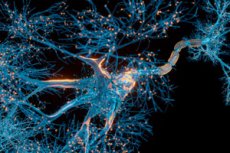
一立方毫米的脑组织看起来可能不多。但考虑到这小小的方块里包含着57000个细胞、230毫米的血管和1.5亿个突触,总计1400TB的数据,哈佛大学和谷歌的研究人员已经取得了巨大的进展。
由杰里米·R·诺尔斯分子和细胞生物学教授兼新任理学院院长杰夫·利希特曼 (Jeff Lichtman) 领导的哈佛大学团队和谷歌研究人员在突触层面创建了迄今为止最大的人类大脑 3D 重建图,生动地展示了人类颞叶皮层中大约半粒米大小的部分中的每个细胞及其神经连接网络。
这项成果发表在《科学》杂志上,是与谷歌研究院科学家近十年合作的最新成果,该合作将利希特曼电子显微镜与人工智能算法相结合,对哺乳动物高度复杂的神经线路进行颜色编码和重建。该论文的三位共同第一作者分别是前哈佛大学博士后 Alexander Shapson-Ko、谷歌研究院的 Michal Januszewski 和哈佛大学博士后 Daniel Berger。
此次合作由美国国立卫生研究院的 BRAIN 计划支持,其最终目标是创建整个小鼠大脑的神经连接高分辨率图,这需要的数据量大约是他们从一立方毫米人类大脑皮层获取的数据量的 1,000 倍。
“碎片”这个词本身就很讽刺。1TB对大多数人来说已经是一个巨大的数字,但人脑的一个碎片——仅仅是人脑中极小的一部分——却有数千TB的数据量。
杰夫·利希特曼(Jeff Lichtman),杰里米·R·诺尔斯(Jeremy R. Knowles)分子和细胞生物学教授
《科学》杂志最新发表的脑图谱包含了此前从未见过的脑结构细节,包括一个稀疏却强大的轴突网络,由多达50个突触连接。研究团队还注意到该组织的一些特殊之处,例如少量轴突形成了广泛的螺旋结构。由于他们的样本取自一位癫痫患者,他们不确定这种异常结构是病理性的还是仅仅是罕见的。
利希特曼的研究领域是“连接组学”。它与基因组学类似,旨在创建完整的大脑结构图谱,直至单个细胞和连接。这些完整的图谱将为科学家对大脑功能和疾病的理解开辟新的途径,而目前科学家对这些疾病知之甚少。
谷歌最先进的人工智能算法可以重建和绘制三维脑组织。该团队还开发了一套可供研究人员探索和注释连接组的公开工具。
谷歌研究员维伦·贾恩 (Viren Jain) 表示:“鉴于该项目投入的巨额资金,以一种其他人可以从中受益的方式展示研究结果非常重要。”
接下来,研究小组将针对小鼠海马体中一个对神经科学很重要的区域进行研究,因为它在记忆和神经系统疾病中发挥着作用。

